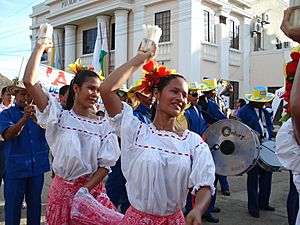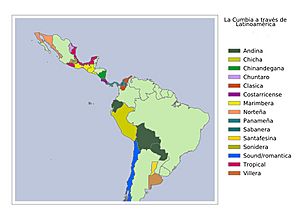Cumbia music facts for kids
Quick facts for kids Cumbia |
|
|---|---|
| Stylistic origins | African music, possibly Guinean cumbe |
| Cultural origins | African and Amerindian slaves in Colombia. |
| Typical instruments | Percussion and woodwind; drums, claves, güiro, flutes and maracas. Other: Saxophone, Trumpets, Keyboards, Trombone, guitar, accordion, Timbales with cowbell. |
| Subgenres | |
| Cumbia villera, Mexican cumbia, Peruvian cumbia | |
| Fusion genres | |
| Cumbia rap | |
| Regional scenes | |
| Colombia - Argentina - Mexico - El Salvador - Bolivia - Peru | |
Cumbia is originally a Colombian folk dance and dance music and is Colombia's representative national dance and music along with vallenato. Cumbia is very popular, widely known in the Latin music mainstream (except Brazil); South America, as well as Central America and Mexico, with lots of regional variations and tendencies. The traditional instruments of cumbia were mainly percussion; different types of drums, claves and a güiro, and woodwinds; flutes.
Modern cumbia includes instrumental mixing; guitars, accordions, bass guitar, modern flutes and modern deep-toned drums and other percussions. The basic rhythm structure is 4/4. Cumbia is the net intersection of two cultures that settled in the region of what is now northern Colombia at different times; the Amerindians and African slaves. Cumbia began as a courtship dance practiced among the slave population that was later mixed with the European instruments and influence.
Origins
Cumbia is believed to be a variant of the African Guinean cumbe music. Cumbia started in the northern region of Colombia, mainly in or around Cartagena during the period of Spanish colonization. Spain used its ports to import African slaves, who tried to preserve their musical traditions and also turned the drums and dances into a courtship ritual. Cumbia was mainly interpreted with just drums and claves.
Cumbia as a courtship ritual
The danced courtship ritual was rhythmically performed with music played by groups of men and women couples; women playfully waving with their long skirts and holding a candle, while the men danced behind the women, with one hand on his back and the other one holding his hat, putting it on and off and waving it. Men also carried a red type of handkerchief which they either wrapped around their necks, waved in circles in the air or handheld together with women. Until mid-20th century, cumbia was considered a dance practiced only by the lower classes.
Musical instruments
Traditional instruments used in cumbia:
- Drums: Cumbia drums were of African origin and were brought along with slaves to the Americas by the Spanish conquerors. Africans used wood, ropes made out of sisal (Agave sisalana), and animal dry skins to make their drums. They either played the drum by hitting it with their hands or with sticks. Sometimes they wrapped the tip of the sticks with dry skin to prevent wearing off the drum. Cumbia interpreters produce variations of the sound emitted by the drum by hitting it on almost every area of the wooden base and dry skin.
- Claves: claves are a couple of hard thick sticks, usually used to set the beat through out the song.
Cumbia in Latin America
- Colombia: Today traditional cumbia is preserved and considered representative of the Colombian identity, but especially in the Northern Caribbean coast. It is also associated to Barranquilla's Carnival and the Vallenato Legend Festival. Modern forms of Cumbia are only preferred by the lower classes, but widely accepted when fusioned with other genres such as vallenato or rock; similar to Carlos Vives signature.
- Argentina: Tends to be appreciated more by the lower social classes, and is often scorned by the upper classes. In Argentina, for example, this social divide is exemplified by the cumbia villera phenomenon, that intends to represent and resonate with the poor and marginalized dwellers of villas miseria (shanty towns and slums). However, it must be noted that a lighter form of cumbia enjoyed widespread popularity in Argentina during the 1990s (see Argentine cumbia).
- Chile: Popular with the lower social classes, it is often made fun of by the middle and upper classes. Nevertheless, it is widely danced at parties and gathering.
- Brazil: Cumbia music is also very popular in Brazil.
See also
 In Spanish: Cumbia para niños
In Spanish: Cumbia para niños



